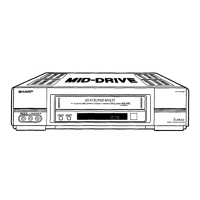BROADCAST SYSTEMS/BEFORE USING YOUR VCR
@
Switch
settings
when
using
your
VCR
to
edit
line
input
signals
while
playing
back
a
tape
with
other
equipment
(VCRs,
etc.),
SECAM
MODE
RF/iF
SYSTEM
,-------~~~.
==:-":b~NTSC
MODE
:OOO::I~
--
"~I
11
I
I"
iiii
t~1l~0\.
COLOUR
MODE
SYSTEM
(RF
Output
System)
• Editing by connecting other equipmentto the VCR via AUDIO IN RlL and VIDEO IN
terminals is called "line input editing". When using this procedure to edit, press the
INPUTbuttonto selectthe externalinput (L1: rearor L2:front).
@ A
classification
of
colour
systems
and
broadcasting
systemsl
Selection
of
recording
speeds
and
speeds
at
which
tapes
can
be
played
back.
YourVCRSwitch Position
Playback
equipment
Front
(inside
the
door)
Rear
Channel
posi-
tion
of
your
playback
mode
COLOUR
MODE
NTSC
MODE
SECAM
MODE
VCR
NTSC3.58
AUTOorNTSC
3.58
NTSC4.43
AUTO
or
NTSC
4.43
Any position
PAL
AUTO
or
PAL
L1
(Rear)
SECAM
AUTO
or
MESECAM
Any position
SECAM
L2
(Front)
MESECAM
AUTO
or
MESECAM
MESECAM
NTSC
....
PAL
CTV
AUTOorNTSC
NTSC
...PAL
CTV
Any position
1 I 2 I
3
4
I
5
6
"1
7
8 9
T
Coloursystem
PAL
SECAM
NTSC
V
Broadcasting System
VHF:B
VHF:D VHF:- VHF:B
VHF:D
VHF:M
-
UHF:G(H
)
UHF:K
UHF:I UHF:G
UHF:K,K1
UHF:M
VHS colour recording system
PAL
PAL
PAL
SECAM
!MESECAM
SECAM
TMESECAM
NTSC
NTSC
3.58
'AS
Pictureandsoundthatcanbe
recorded
SP/LP
SP/LP
SP/EP
V
(Sound:
Lineartrack)
H
Hi-Fitrack sound recording
SP/LP SP/LP
SP
S
Playback
(Sound:
Linear
track)
SP/LP
gP/LP
SP/LP/EP
Playback
(Sound:
Hi-Fi
track)
SP/LP
SP/LP
SP/LP/EP
YourTV
Your
VCR
Recording
a broadcast
Playing
back
a
tape
System
mode
(Reter
PAL
PAL
PAL-
SECAM
French
SECAM
NTSC
PAL
M_
SECAM
NTSC
to
table@)
BIG
I
D/K
BIG
SECAM
IlJ1\Kl
(M)
I~~m
L
PAL-B/G
PAL-BIG
0
0
PAL-I
PAL-I
0
0
PAL-D/K
PAL-D/K
0
0
MESECAM·B!G
0*
0
SECAM-B/G
0
0
BECAM-B/G
l!.
l!.
SECAM·L
l!.
l!.
BECAM-D/K
BECAM-DIK
0
0
-Kt
MESECAM·D/K
0*
0
NTSC
3.58(M)
NTSC
3.58
0
0
NTSC
4.43
NTSC
4.43
0
o
Recording
broadcastsfTape
playback
for
each
of
the
modes
of
your
VCR
and
each
type
of
TV.
• The table above indicates the colour television system you should use, as
well as the setting for each switch, when using your VCR to record signals in
each broadcasting system, or to play back tapes from each of the different
colour systems.
For
example, when using a colour
TV
which uses a PAL-
B/G system, if you select the PAL-B/G mode on your VCR (refer to table
~
for
the
setting
of
each
switch),
you
will
be
able
to
record
PAL-B/G
broadcasts, and also play back PAL tapes.
•
"~"
indicates
that
recording and
playback
are
not
possible
unless
you
connect your TV to the VCR with the AUDIO IN/OUT and VIDEO IN/OUT
terminals. Consequently, this mark indicates that you can only use a TV that
is equipped with AUDIO IN/OUT and VIDEO IN/OUT terminals.
• "0" indicates that recording and playback are possible when you connect
your TV to the
VCR
using either the AUDIO IN/OUT and VIDEO IN/OUT
terminals or the RF OUT terminal.
• When recording a French SECAM-L broadcast, and when playing back a
SECAM
tape
using
a
SECAM-L
TV,
connect
your
TV using
the
AUDIO
IN/OUT and VIDEO IN/OUT terminals.
·
"*"
indicates that a SECAM signal is being recorded using the MESECAM
system.
• The following are definitions of each kind of tape:
• PALtapes: Commercially marketed PALtapes, and tapes on which PAL-
B/G,
PAL-I,
PAL-D/K
(DIRT)
broadcasts have been
recorded.
•
SECAM
tapes: Commercially marketed SECAM tapes (including those
marketed in France), and tapes on which SECAM-B/G,
SECAM-D/K,
K1
(DIRT),
and SECAM-Lbroadcasts have been
recorded
in the
SECAM
system.
•
MESECAM
tapes: Tapes on which SECAM-B/G, SECAM-D/K, and
K1
(DIRT)
broadcasts
havebeen
recorded
Inthe
MESECAM
system.
• NTSCtapes: Commercially marketed NTSC tapes and tapes on which
NTSC-M
broadcasts havebeenrecorded.
[Ijs

